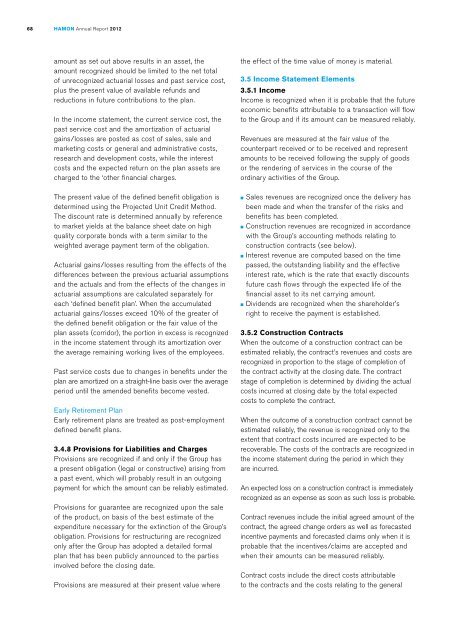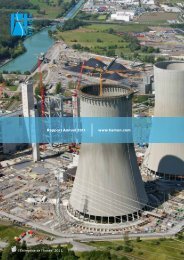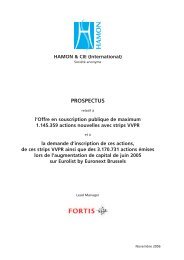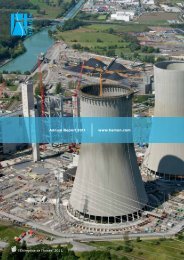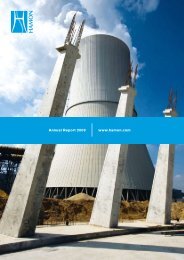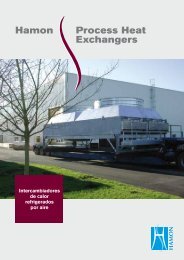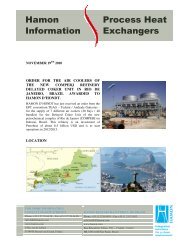Download PDF version English (3237KB) - Hamon
Download PDF version English (3237KB) - Hamon
Download PDF version English (3237KB) - Hamon
You also want an ePaper? Increase the reach of your titles
YUMPU automatically turns print PDFs into web optimized ePapers that Google loves.
68<br />
<strong>Hamon</strong> Annual Report 2012<br />
amount as set out above results in an asset, the<br />
amount recognized should be limited to the net total<br />
of unrecognized actuarial losses and past service cost,<br />
plus the present value of available refunds and<br />
reductions in future contributions to the plan.<br />
In the income statement, the current service cost, the<br />
past service cost and the amortization of actuarial<br />
gains/losses are posted as cost of sales, sale and<br />
marketing costs or general and administrative costs,<br />
research and development costs, while the interest<br />
costs and the expected return on the plan assets are<br />
charged to the ‘other financial charges.<br />
The present value of the defined benefit obligation is<br />
determined using the Projected Unit Credit Method.<br />
The discount rate is determined annually by reference<br />
to market yields at the balance sheet date on high<br />
quality corporate bonds with a term similar to the<br />
weighted average payment term of the obligation.<br />
Actuarial gains/losses resulting from the effects of the<br />
differences between the previous actuarial assumptions<br />
and the actuals and from the effects of the changes in<br />
actuarial assumptions are calculated separately for<br />
each ‘defined benefit plan’. When the accumulated<br />
actuarial gains/losses exceed 10% of the greater of<br />
the defined benefit obligation or the fair value of the<br />
plan assets (corridor), the portion in excess is recognized<br />
in the income statement through its amortization over<br />
the average remaining working lives of the employees.<br />
Past service costs due to changes in benefits under the<br />
plan are amortized on a straight-line basis over the average<br />
period until the amended benefits become vested.<br />
Early Retirement Plan<br />
Early retirement plans are treated as post-employment<br />
defined benefit plans.<br />
3.4.8 Provisions for Liabilities and Charges<br />
Provisions are recognized if and only if the Group has<br />
a present obligation (legal or constructive) arising from<br />
a past event, which will probably result in an outgoing<br />
payment for which the amount can be reliably estimated.<br />
Provisions for guarantee are recognized upon the sale<br />
of the product, on basis of the best estimate of the<br />
expenditure necessary for the extinction of the Group’s<br />
obligation. Provisions for restructuring are recognized<br />
only after the Group has adopted a detailed formal<br />
plan that has been publicly announced to the parties<br />
involved before the closing date.<br />
Provisions are measured at their present value where<br />
the effect of the time value of money is material.<br />
3.5 Income Statement Elements<br />
3.5.1 Income<br />
Income is recognized when it is probable that the future<br />
economic benefits attributable to a transaction will flow<br />
to the Group and if its amount can be measured reliably.<br />
Revenues are measured at the fair value of the<br />
counterpart received or to be received and represent<br />
amounts to be received following the supply of goods<br />
or the rendering of services in the course of the<br />
ordinary activities of the Group.<br />
■ Sales revenues are recognized once the delivery has<br />
been made and when the transfer of the risks and<br />
benefits has been completed.<br />
■ Construction revenues are recognized in accordance<br />
with the Group’s accounting methods relating to<br />
construction contracts (see below).<br />
■ Interest revenue are computed based on the time<br />
passed, the outstanding liability and the effective<br />
interest rate, which is the rate that exactly discounts<br />
future cash flows through the expected life of the<br />
financial asset to its net carrying amount.<br />
■ Dividends are recognized when the shareholder’s<br />
right to receive the payment is established.<br />
3.5.2 Construction Contracts<br />
When the outcome of a construction contract can be<br />
estimated reliably, the contract’s revenues and costs are<br />
recognized in proportion to the stage of completion of<br />
the contract activity at the closing date. The contract<br />
stage of completion is determined by dividing the actual<br />
costs incurred at closing date by the total expected<br />
costs to complete the contract.<br />
When the outcome of a construction contract cannot be<br />
estimated reliably, the revenue is recognized only to the<br />
extent that contract costs incurred are expected to be<br />
recoverable. The costs of the contracts are recognized in<br />
the income statement during the period in which they<br />
are incurred.<br />
An expected loss on a construction contract is immediately<br />
recognized as an expense as soon as such loss is probable.<br />
Contract revenues include the initial agreed amount of the<br />
contract, the agreed change orders as well as forecasted<br />
incentive payments and forecasted claims only when it is<br />
probable that the incentives/claims are accepted and<br />
when their amounts can be measured reliably.<br />
Contract costs include the direct costs attributable<br />
to the contracts and the costs relating to the general


